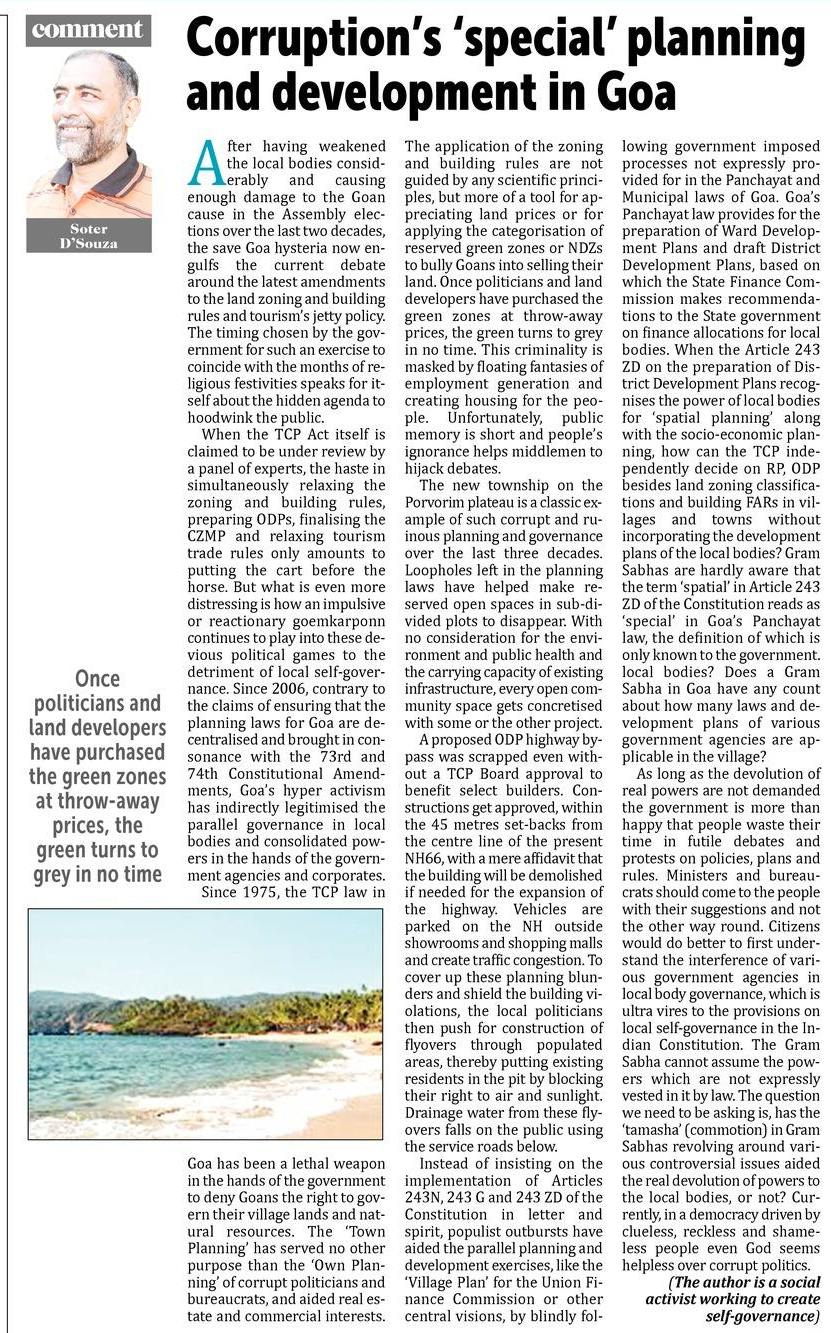Published as lead article in oHeraldo dtd., Sept. 26, 2022
After having weakened the local bodies considerably and causing enough damage to the Goan cause in the Assembly elections over the last two decades, the save Goa hysteria now engulfs the current debate around the latest amendments to the land zoning and building rules and tourism’s jetty policy. The timing chosen by the government for such an exercise to coincide with the months of religious festivities speaks for itself about the hidden agenda to hoodwink the public.
When the TCP Act itself is claimed to be under review by a panel of experts, the haste in simultaneously relaxing the zoning and building rules, preparing ODPs, finalising the CZMP and relaxing tourism trade rules only amounts to putting the cart before the horse. But what is even more distressing is how an impulsive or reactionary goemkarponn continues to play into these devious political games to the detriment of local self-governance. Since 2006, contrary to the claims of ensuring that the planning laws for Goa are decentralised and brought in consonance with the 73rd and 74th Constitutional Amendments, Goa’s hyper activism has indirectly legitimised the parallel governance in local bodies and consolidated powers in the hands of the government agencies and corporates.
Since 1975, the TCP law in Goa has been a lethal weapon in the hands of the government to deny Goans the right to govern their village lands and natural resources. The ‘Town Planning’ has served no other purpose than the ‘Own Planning’ of corrupt politicians and bureaucrats, and aided real estate and commercial interests. The application of the zoning and building rules are not guided by any scientific principles, but more of a tool for appreciating land prices or for applying the categorisation of reserved green zones or NDZs to bully Goans into selling their land. Once politicians and land developers have purchased the green zones at throw-away prices, the green turns to grey in no time. This criminality is masked by floating fantasies of employment generation and creating housing for the people. Unfortunately, public memory is short and people’s ignorance helps middlemen to hijack debates.
The new township on the Porvorim plateau is a classic example of such corrupt and ruinous planning and governance over the last three decades. Loopholes left in the planning laws have helped make reserved open spaces in sub-divided plots to disappear. With no consideration for the environment and public health and the carrying capacity of existing infrastructure, every open community space gets concretised with some or the other project.
A proposed ODP highway bypass was scrapped even without a TCP Board approval to benefit select builders. Constructions get approved, within the 45 metres set-backs from the centre line of the present NH66, with a mere affidavit that the building will be demolished if needed for the expansion of the highway. Vehicles are parked on the NH outside showrooms and shopping malls and create traffic congestion. To cover up these planning blunders and shield the building violations, the local politicians then push for construction of flyovers through populated areas, thereby putting existing residents in the pit by blocking their right to air and sunlight. Drainage water from these flyovers falls on the public using the service roads below.
Instead of insisting on the implementation of Articles 243N, 243 G and 243 ZD of the Constitution in letter and spirit, populist outbursts have aided the parallel planning and development exercises, like the ‘Village Plan’ for the Union Finance Commission or other central visions, by blindly following government imposed processes not expressly provided for in the Panchayat and Municipal laws of Goa. Goa’s Panchayat law provides for the preparation of Ward Development Plans and draft District Development Plans, based on which the State Finance Commission makes recommendations to the State government on finance allocations for local bodies. When the Article 243 ZD on the preparation of District Development Plans recognises the power of local bodies for ‘spatial planning’ along with the socio-economic planning, how can the TCP independently decide on RP, ODP besides land zoning classifications and building FARs in villages and towns without incorporating the development plans of the local bodies? Gram Sabhas are hardly aware that the term ‘spatial’ in Article 243 ZD of the Constitution reads as ‘special’ in Goa’s Panchayat law, the definition of which is only known to the government. local bodies? Does a Gram Sabha in Goa have any count about how many laws and development plans of various government agencies are applicable in the village?
As long as the devolution of real powers are not demanded the government is more than happy that people waste their time in futile debates and protests on policies, plans and rules. Ministers and bureaucrats should come to the people with their suggestions and not the other way round. Citizens would do better to first understand the interference of various government agencies in local body governance, which is ultra vires to the provisions on local self-governance in the Indian Constitution. The Gram Sabha cannot assume the powers which are not expressly vested in it by law. The question we need to be asking is, has the ‘tamasha’ (commotion) in Gram Sabhas revolving around various controversial issues aided the real devolution of powers to the local bodies, or not? Currently, in a democracy driven by clueless, reckless and shameless people even God seems helpless over corrupt politics.
(The author is a social activist working to create self-governance)
https://www.heraldgoa.in/Edit/Opinions/Corruption%E2%80%99s-%E2%80%98special%E2%80%99-planning-and-development-in-Goa/194542

No comments:
Post a Comment